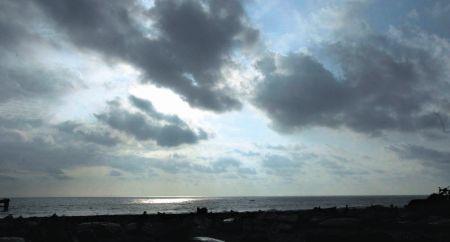Pre-monsoon clouds unseen anywhere in India as yet
Mangalore Today News Network
New Delhi, Apr 23, 2016: The circustanes at present is, 30 out of 36 meteorological subdivisions received either zero or very little rainfall in the last one week, weather scientists are now lost on arrival of pre-monsoon showers. "It is very unusual. April sees thunderstorms and pre-monsoon showers in the South and North East. But there is no sign now. The air is devoid of moisture," M Rajeevan, secretary in the Ministry of Earth Sciences told media.
"It is very unusual. April sees thunderstorms and pre-monsoon showers in the South and North East. But there is no sign now. The air is devoid of moisture," M Rajeevan, secretary in the Ministry of Earth Sciences told media.
At least 12 meteorological subdivisions in central, southern and western India as well as the Andaman and Lakshadweep islands received no rain in the last one week.
The rainfall received in most other subdivisions fall in the scanty category (-60 to -99%), whereas in coastal Karnataka, showers are in the deficient (-59%) category. The only sub-division that received excess precipitation is Assam and Meghalaya. Five other sub-divisions in the East and North East besides Jammu and Kashmir and Himachal Pradesh received normal rainfall.
A comparison with last year’s data showed 23 out of 36 sub-divisions had either normal or excess rainfall this time of the year. Three sub-divisions experienced zero rainfall.
"This could be due to the El Nino effect, but we need better analysis. Pre-monsoon showers take place because of a combination of atmospheric circulation and the presence of moisture in the air which is yet missing," said Rajeevan.
With skies drying up, the water tables have gone down sharply. The water storage available in 91 major reservoirs is just about 22% of their capacity. The southern region is the worst affected where the water level in 31 reservoirs is just 14% of the live storage capacity. The water storage available in 91 major reservoirs is just about 22% of their capacity.
The weather office, on Apr 22, Friday, issued heat wave warning for Telangana, Rayalaseema, Jharkhand and Odisha whereas people in other parts of central and western India have been advised to be on alert for heat wave-like conditions.
The heat waves over India are projected to be more intense and occur more frequently in future. Climatologically heatwaves occur during March to June, with high frequency over north, north-west, central and the eastern coastal regions of India. But the dynamics are different.
"Based on the observed patterns and statistical analyses of the maximum temperature variability, we identified two types of heatwaves. The first-type of heatwave over the north-central India associated with a weather phenomenon in North Atlantic. The second type of heatwave over the coastal eastern India is due to the anomalous cooling in the Pacific," said Rajeevan, who analysed the head wave pattern with colleagues from India and Japan.
Last year, about 2,200 Indians died from heat wave. The toll was higher in 2003 when more than 3,000 people perished in different parts of India.
- Udupi second city in coastal Karnataka to announce water rationing
- Kasargod: 3 dead in horrific crash between car and ambulance at Manjeshwar
- Man found dead outside auditorium at B C Road
- Bantwal: Group assaults KSRTC bus driver
- Under trial prisoner under treatment ends life
- 93 seats in 11 states, union territories vote in phase 3 today
- Mangaluru International Airport bags Apex India OHS Platinum Award
- First batch of Haj pilgrims from DK, Udupi to depart on May 9
- Man found dead at Panambur beach
- Outstanding board results of St Theresa’s ICSE school, Bendur
- Eminent Konkani writer, KWAA President Ronald Sequeira no more
- Moodbidri: Pre-University student dies by suicide in her hostel room
- Mahila Congress stages protest; demands arrest of Prajwal Revanna
- Karnataka groom calls off wedding after bride’s family fails to serve sweets
- Arvind Kejriwal fails to get immediate relief from Supreme Court in money laundering case
- Celebrities, influencers equally liable for deceptive ads: Supreme Court
- Nearly 51 per cent turnout until 3 pm as India votes in Phase 3
- 3 terrorists killed in encounter in Jammu and Kashmir’s Kulgam
- 5th accused in Salman Khan house firing case arrested from Rajasthan
- How a Rs 10,000 bribe led to recovery of crores in Jharkhand
- PM Modi votes in Ahmedabad, huge crowd gathers outside voting booth
- Maldives urges Indians to ’be a part’ of its tourism, economy depends on it
- Supreme Court to consider interim bail for Arvind Kejriwal today
- 11-Year-Old pune boy dies after Cricket ball hits his genitals
- ICICI Bank enables UPI payments in India for NRI customers
- New residential complex for the judges inaugurated in Mangaluru
- Absconding accused nabbed after 8 years
- Truck with cylinders turns turtle in Beltangady
- Bhoota Kola artist dies of cardiac arrest
- Development of the country should be our goal: Ganesh Karnik
- Container truck gets stuck under Modankap railway bridge
- Truck crushes bike’s pillion rider near BC Road
- Head constable dies of heart attack
- Udupi: PDO dismissed over financial irregularities
- CREDAI to resume Skill Development Program for Construction Workers in Mangaluru
- John B Monteiro elected president of Rachana Catholic Chamber of Commerce & Industry
- Sudhanshu Rai elected district president of All College Student Association
- Chief Minister to visit Mangaluru, Udupi on August 1
- Nitte University awards PhD degree to Tina Sheetal D’Souza
- Sachitha Nandagopal honoured by CMTAI for Community Service
- CITY INFORMATION
- TRAVEL
- TOURIST INFORMATION
- HEALTH CARE
- MISCELLANEOUS




 Write Comment
Write Comment E-Mail To a Friend
E-Mail To a Friend Facebook
Facebook Twitter
Twitter  Print
Print 

